Support teams help transport supplies
 One of 11 military aircraft arrives in Wuhan, Hubei province, on Feb 13. The planes carried 2,600 medical professionals. (CHEN XIAODONG / FOR CHINA DAILY)
One of 11 military aircraft arrives in Wuhan, Hubei province, on Feb 13. The planes carried 2,600 medical professionals. (CHEN XIAODONG / FOR CHINA DAILY)
Editor's note: Novel coronavirus pneumonia is posing a worldwide threat. Here, we take a look at how China is playing its role in the global fight against the outbreak by mobilizing a vast amount of resources to contain the epidemic. This is the fifth part of a series titled "United Actions".
Wang Huan spent 18 hours walking and traveling by taxi, electric motorcycle, airplane and even police car to reach her workplace in Wuhan, Hubei province, on Jan 26, the third day of the Spring Festival holiday.
The 22-year-old nurse's decision to return to her job at a military hospital was made on the first day of the vacation after the facility appealed for staff members to voluntarily return to work.
Wang also saw on her phone that many of her colleagues had responded positively to the call in her department's chat group.
Sitting at home in Siping, Jilin province, Wang texted her friend Shu Chun, a fellow nurse at the General Hospital of the People's Liberation Army Central Theater Command, to discuss what they should do. Both agreed they should return to their jobs in Wuhan as soon as possible.
However, because of the lockdown enforced in the city on Jan 23, all air, rail and bus services to Wuhan, the epicenter of the novel coronavirus pneumonia outbreak, had been suspended.
The pair came up with a solution-they would meet in Shu's hometown in Yifeng county, Jiangxi province, and hire a local driver to take them to Wuhan.
First, Wang bought an air ticket from Changchun, capital of Jilin, which is more than 150 kilometers from her hometown, to Nanchang, capital of Jiangxi.
She left home at about 5 am on Jan 26 to catch the early morning flight from Changchun airport. There were only 10 passengers on the plane.
At Nanchang airport, Wang was told by a taxi driver that she must pay extra, or he would not take her. This was because her phone number was registered in Hubei and the driver believed she was from that province.
After the two nurses met in Yifeng county, they quickly realized that no taxi or ride-hailing service driver would take them, even though they said they were willing to pay 3,000 yuan (US$431) for the four-hour ride to Wuhan.
They had no choice but to drag their luggage to the nearest police station in the hope of getting help. Officers at the station suggested the nurses should go to the county police bureau to see if they could get assistance there.
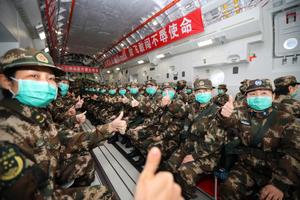 The military has deployed more than 4,000 medical personnel in Wuhan as part of epidemic control efforts since Jan 24. (CHEN XIAODONG / FOR CHINA DAILY)
The military has deployed more than 4,000 medical personnel in Wuhan as part of epidemic control efforts since Jan 24. (CHEN XIAODONG / FOR CHINA DAILY)
The two trekked toward the bureau without seeing any private cars on the streets, let alone a taxi.
Just as they thought that all hope had deserted them, two shared motorcycles came into view.
"I was thinking it would be great if we could take them all the way to Wuhan," Wang said.
"Finally, we reached the police bureau in Yifeng and told the officers we were workers at a military hospital in Wuhan and had to return to our positions that day."
The bureau chief relayed their request to the county government, which approved it and authorized police officers to drive the pair to Wuhan.
Four hours later, a police car dropped them at a highway checkpoint on the outskirts of the city, where they were picked up by a car sent by their hospital.
Since their return, Wang and Shu have been busy nursing patients infected with the highly contagious disease.
"If the epidemic had not occurred, we would just be nurses, but because of the outbreak, we now feel more like soldiers," Shu said.
On Feb 14, Shu wrote in a WeChat post of her determination to continue the fight against the virus. The post received many "likes", including one from her landlady in Wuhan, who wrote: "I can't do anything for you, but I will cancel your rent for the next three months. Take good care of yourself."
Knowing that medics face a high risk of infection, Shu's parents message her every day, telling her to be careful at work. However, she said she is not daunted by the virus.
"As soldiers, we will never be quitters or deserters. This is exactly the time for us to come forward. If we don't, who will?" she said.
"My 14-year-old sister asked me when I would return home. I told her that it would be in the spring."
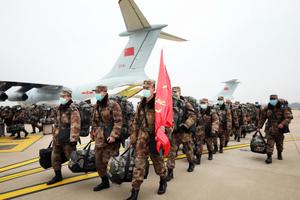 The military has deployed more than 4,000 medical personnel in Wuhan as part of epidemic control efforts since Jan 24. (CHEN XIAODONG / FOR CHINA DAILY)
The military has deployed more than 4,000 medical personnel in Wuhan as part of epidemic control efforts since Jan 24. (CHEN XIAODONG / FOR CHINA DAILY)
Thousands treated
Chen Yi, a chief nurse at the Navy Medical University Changhai Hospital in Shanghai, said that when the facility announced it was sending workers to Wuhan to help fight the outbreak, nearly all its doctors and nurses volunteered to go.
"Some young nurses didn't tell their parents they had been selected to go to Wuhan, in case they became too worried and tried to stop them," she said.
Following instructions from President Xi Jinping, also general secretary of the Communist Party of China Central Committee and chairman of the Central Military Commission, since Jan 24, the military has deployed more than 4,000 medical personnel to join epidemic control efforts in Wuhan.
Major General Chen Jingyuan, the top health official at the Central Military Commission's Logistics Support Department, said that as of March 1, three medical facilities in Wuhan currently under military management had treated 3,467 patients in critical condition, and 689 of them had been discharged after recovering.
The facilities are Huoshenshan Hospital, Taikang Tongji Hospital and the Guanggu branch of Hubei Maternity and Child Health Care Hospital.
Moreover, 63 military hospitals nationwide tasked with receiving patients with the disease have provided nearly 3,000 beds, and more than 10,000 medics at these institutions are fighting the outbreak.
By March 1, military medical workers had seen 4,450 patients, with 1,000 of them being discharged after recovering, Chen said, adding that no military medics had been infected.
Chen added that the armed forces have allocated 400,000 medical masks, 8,000 protective suits and other medical equipment to Wuhan.
To deploy personnel as quickly as possible, on Jan 24, the PLA Air Force began using its transport planes to send military medics and materials to Wuhan. Three aircraft carried 450 medical workers and supplies to the city before midnight that day-Lunar New Year's Eve.
Since then, the Air Force has organized four air transport operations, involving 30 flights to Wuhan.
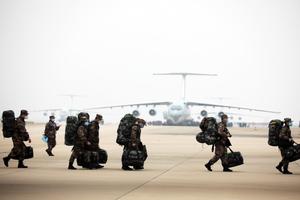 Medical professionals disembark from one of the eight military aircraft that arrived in Wuhan on Feb 2, carrying 795 personnel and 58 metric tons of goods. (CHEN XIAODONG / FOR CHINA DAILY)
Medical professionals disembark from one of the eight military aircraft that arrived in Wuhan on Feb 2, carrying 795 personnel and 58 metric tons of goods. (CHEN XIAODONG / FOR CHINA DAILY)
During the third mission on Feb 13, the Air Force used six Y-20, three Il-76 and two Y-9 transport planes to take hundreds of medics and supplies to Wuhan from seven cities across the country. The cities included Urumqi, capital of Xinjiang Uygur autonomous region, Shenyang, capital of Liaoning province, and Chengdu, capital of Sichuan province.
It is believed to be the largest-ever non-military operation undertaken by the Air Force's transport fleet. The mission also marked the first non-military deployment of the domestically developed Y-20, one of the world's largest strategic heavy-lift transport planes.
Yang Jun, commander of a transport regiment that joined the air operations, told China Central Television he was honored to pilot a Y-20 to answer the call for help from people in Wuhan. He added that his aviators are always ready to fly their aircraft to fulfill their missions.
Military observers said such large-scale deployments testify to the PLA Air Force's strong operational capability.
Du Wenlong, a retired researcher from the PLA Academy of Military Science, said that sending six huge Y-20 jets in a single operation underscored the Air Force's improved emergency response and transport capabilities.
"These tasks also demonstrated the Air Force's strong combat potential and the Chinese aviation industry's impressive manufacturing capacity," Du said.
Wu Peixin, an aviation industry observer in Beijing, said such operations highlighted the Air Force's ability to mobilize a large transport group at short notice.
"It showed that the crews involved are well trained and prepared to respond to emergencies or difficult missions," he said.
Wang Yanan, editor-in-chief of Aerospace Knowledge magazine, said the military's heavy-lift planes enable the government to transport sizeable medical devices more quickly and conveniently, compared with civilian aircraft.
"In addition to enabling medics to reach Wuhan as soon as possible, these operations can also serve to verify and improve the Air Force's ability to mobilize aviation units, organize large-scale, sophisticated deployment and provide logistics support for such tasks," Wang said.
As well as air operations, the PLA is using its trucks to help distribute daily necessities and medical supplies to markets, shops and hospitals in Wuhan.
Since late January, the outbreak has caused shortages of manpower and transportation in the city's logistics businesses, forcing the authorities to seek help from the military.
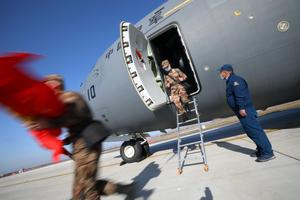 The military has deployed more than 4,000 medical personnel in Wuhan as part of epidemic control efforts since Jan 24. (CHEN XIAODONG / FOR CHINA DAILY)
The military has deployed more than 4,000 medical personnel in Wuhan as part of epidemic control efforts since Jan 24. (CHEN XIAODONG / FOR CHINA DAILY)
Supplies delivered
After receiving an order from the Central Military Commission, the PLA Hubei Provincial Command cooperated with a number of military units stationed in the province, including the PLA Air Force's parachute and aviation units and the PLA Ground Force's training base.
Troops and trucks from these units formed a transportation support team on Feb 2, comprising 260 soldiers and 130 trucks.
The team helps local logistics companies transport daily necessities, such as vegetables, to markets and assists local government departments to deliver supplies to temporary hospitals such as Huoshenshan and Leishenshan.
On the day it was formed, the team dispatched 50 trucks to deliver more than 200 metric tons of necessities to major supermarkets across Wuhan.
Drivers usually leave the team's base early in the morning to deliver goods. With requests for help arriving daily, they often have no time for lunch or dinner.
Xie Chaohui, a member of the team whose family lives in Wuhan, said both he and his wife, a nurse at a local hospital, are too busy to take care of their 6-year-old son. As a result, the child is staying with his grandparents.
"My mother-in-law lives on a road I use each day to deliver vegetables to a market, so I can pull over outside her house and see my son through the window. He sees me and waves at me," he said.
In the past month, drivers on the team have transported more than 8,500 tons of necessities and 23,600 sets of medical equipment in Wuhan.
China Central Television quoted Xiong Zhuang, duty manager at a supermarket in the city, as saying that the military drivers' assistance has greatly eased the heavy burden facing the business.
Xiong said he wanted to thank the soldiers for their help, adding that people in Wuhan felt more assured when they saw troops in the city.
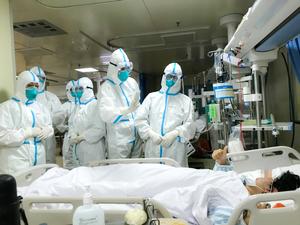 A patient gives the thumb up to PLA doctors. (CHEN JING / XINHUA)
A patient gives the thumb up to PLA doctors. (CHEN JING / XINHUA)
Chen, from the Central Military Commission's Logistics Support Department, told the media on March 2 that, faced with this sudden health crisis, the PLA had shown its ability to follow orders and fight hard.
"The achievements made in epidemic control have again shown the obvious advantages of the leadership of the Communist Party of China and socialism with Chinese characteristics," Chen said.
At the news conference on March 2, Defense Ministry spokesman Wu Qian was asked by the media about claims made by foreign analysts that the epidemic is likely to have an impact on the combat readiness of the Chinese military.
The senior colonel said the outbreak would not affect combat training and exercises, and the military had comprehensively demonstrated its emergency response capabilities in battling the epidemic.
Wu said that the PLA has maintained its normal routine training of troops since the outbreak emerged in January, adding that equal attention is paid to epidemic prevention and combat training.
"Our armed forces have the responsibility to take part in disaster relief, emergency response and rescue missions," Wu added.
"The military's active participation in the fight against the disease will not only comprehensively show the troops' emergency response ability but also hone their operational skills. It could be seen as a combat exercise."


